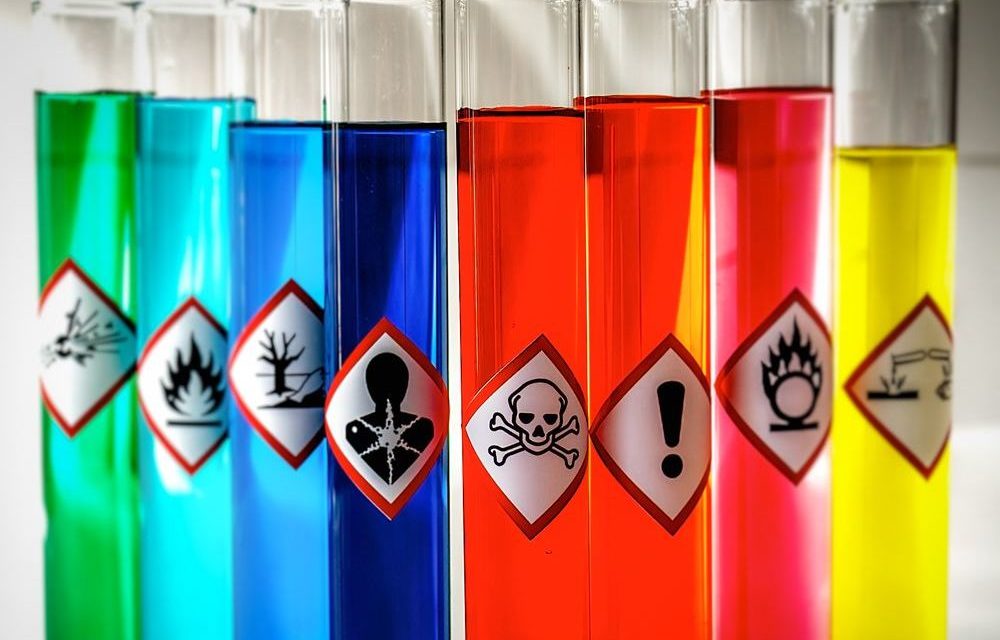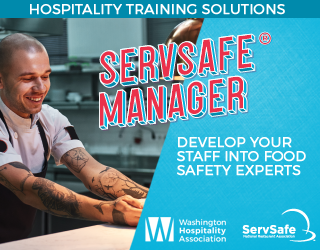What is the Hazard Communication rule?
The Hazard Communication rule requires you — the employer — to inform and train your employees about hazardous chemicals in your workplace.
Note: Washington State’s new Hazard Communication rule, WAC 296-901-140, became effective April 15, 2013. It replaces the Employer Hazard Communication rule, WAC 296-800-170. The changes are based on the International Globally Harmonized System of Classification and Labeling of Chemicals (GHS) and are intended to improve comprehension of hazard information found on product labels. For more information about GHS and Hazard
Communication, visit www.Lni.wa.gov/Safety/Topics/AtoZ/GHS.
The major changes include:
- Hazard Classification providing specific criteria for classification of health and physical hazards, as well as classification of mixtures.
- More standardized labels that feature:
- Hazard pictograms
- A signal word, such as “Danger”
- Hazard statement for each hazard class and category, including precautionary statements
- A product identifier and a supplier identifier
- Safety Data Sheets (SDSs) that follow a standardized 16-section format to replace Material Safety Data Sheets (MSDSs.)
Although content details on labels and SDSs are affected by the GHS, many of the current requirements are not changing. For example, requirements to distribute SDSs, label workplace containers and train employees remain the same.
Which state agency administers this rule?
The Washington State Department of Labor & Industries (L&I) administers this rule and other occupational safety and health rules through its Division of Occupational Safety and Health (DOSH). The Hazard Communication rule is part of the Washington Administrative Code, WAC 296-901-140.
Do I need to read the Hazard Communication rule?
Yes! You can easily access the full requirements of the rule at www.Lni.wa.gov/Safety/Rules/Chapter/901 . Visit the Hazard Communication topic page at www.Lni.wa.gov/Safety/Topics/AtoZ/GHS for additional resources, such as:
- A sample written program for chemical hazard communication
- Sample forms
- Training materials
- Safety videos
If you have one or more employees who handle or are exposed to chemicals at your workplace, you must comply with this rule to meet your obligations as an employer. Failure to do so could lead to safety and health citations and penalties.
Checklist of Requirements
In addition to reading the Hazard Communication rule, ask yourself the following questions to determine if your business has met all the safety mand health requirements for the rule:
- Have we prepared a list of all the hazardous chemicals in the workplace?
- Do we update our hazardous chemical list regularly?
- Have we obtained or developed a Safety Data Sheet (SDS) for each hazardous chemical we use?
- Do we have a system to ensure that we check all incoming hazardous chemicals for proper labels and SDSs?
- Do we have procedures to ensure proper labeling or warning signs for containers that hold hazardous chemicals?
- Are employees aware of the specific information and training requirements of our hazard
- communication program?
- Are employees familiar with the different types of chemicals and the hazards associated with them?
- Have employees been informed of the hazards associated with performing non-routine tasks?
Do employees understand how to detect the presence or release of hazardous chemicals in the workplace?
- Are employees trained about proper work practices and personal protective equipment in relation to the hazardous chemicals in their work areas?
- Does our training program provide information on appropriate first aid, emergency procedures and the likely symptoms of overexposure?
- Does our training program include an explanation of labels and warnings that are used in each work area?
- Does our training describe where to obtain SDSs and how employees may use them?
- Do we have a system to ensure that we train new employees before beginning work?
- Have we developed a system to identify new hazardous chemicals before we introduce them into a work area?
- Do we have a system for informing employees when we learn of new hazards associated with a chemical we use?
- Do we have a records retention system that will retain the SDSs or the alternative record for a minimum of 30 years?
Safety Data Sheets (SDSs)
- If I buy a hazardous chemical from a retail outlet (such as rust remover from a hardware store or fertilizer from a nursery), who will provide the SDS?
Retail distributors are required to provide SDSs to only those customers with commercial accounts who make requests. The retailer must post a sign informing employers that an SDS is available. If you do not have a commercial account, you are responsible for requesting an SDS from the manufacturer, importer or wholesale distributor.
Wholesale distributors selling hazardous chemicals to employers over the counter may also provide SDSs upon the request of the employer at the time of the over-the-counter purchase, and they must also post a sign or otherwise inform such employers that an SDS is available.
If you do not have a commercial account and you purchase a hazardous chemical from a retail distributor not required to have an SDS on file (such as if the retail distributor does not have commercial accounts and does not use the materials), the retail distributor must provide you, upon request, with the name, address and telephone number of the chemical manufacturer, importer or distributor so that you can get an SDS.
SDS sheets can also be found using Google.
- Are farm-chemical distributors required to provide SDSs?
Yes. All manufacturers, importers and distributors must provide SDSs to employers who purchase hazardous chemicals. This includes pesticide dealers. Pesticide applicators that sell pesticides are considered distributors for the purposes of the rule.
- What should I do if I get an SDS with blank spaces on it?
Contact the manufacturer or importer for a complete SDS. The person who prepares the SDS must fill out the form completely. All elements of an SDS are now required; if no relevant information is found for any subheading within a section on the SDS, it must be marked to indicate that no applicable information was found.
- Who is responsible for the accuracy of SDSs?
The manufacturer, importer or employer preparing the SDS must make certain the information accurately reflects the scientific evidence used in making the hazard determination.
- Can SDSs be kept and made available electronically if employees have proper access and knowledge of how to use them?
Yes. The rule says that an SDS may be in any form if it contains the required information. You must make certain the required information is provided for each hazardous chemical and is readily accessible to employees in each work area on each shift.
- How often do SDSs need to be updated?
Each SDS must be updated within three months of the time the manufacturer, importer or employer learns of any significant new information pertaining to the hazards of the chemical or ways to protect against the hazards.
- Do I have to obtain SDSs on hazardous chemicals we don’t use very often?
Yes. You must keep an SDS on each hazardous chemical used in your workplace.
- Do contractors have to make SDSs available to their employees when they are working at non-fixed locations, such as construction sites?
Yes. SDSs may be kept at the contractor’s permanent base if employees leave and return from that location daily. Contractors who establish a temporary base, such as a trailer at a work site, are required to have SDSs available at the site.
- Must SDSs be translated into a foreign language if most workers don’t speak English?
No. However, a reasonable effort must be made to inform all employees of the hazards in the workplace. L&I will, upon request, aid with translations for the following languages: Cambodian, Chinese, Korean, Spanish and Vietnamese.
- Will L&I approve all SDSs?
No. L&I does not approve the content of SDSs but will review them on a spot-check basis for completeness and accuracy.
- How are laboratories covered under the rule?
Laboratories, including school and college labs, have limited coverage under the rule as described in WAC 296-901-14004. They must follow the “Hazardous Chemicals in Labs” rule, WAC 296-828, if it applies.
- Are laboratories required to obtain SDSs for all hazardous chemicals, even those that are old or infrequently used?
No. Laboratories are only required to keep SDSs that are received for hazardous chemicals. These SDSs must always be available to laboratory personnel. L&I recommends that laboratories obtain as many SDSs as possible to help in developing their training programs.
- Are schools and colleges required to tell students about the hazards of chemicals they handle or are exposed to?
Teaching assistants, laboratory assistants and students employed by schools are covered under the Hazard Communication rule and must receive information and training.
- If I don’t get an SDS with a product, can I assume it’s not hazardous?
No. You should call or write the manufacturer and ask for an SDS if you suspect a chemical may be hazardous.
Labels and Record Keeping
- What does the rule require for labeling?
The Hazard Communication rule requires that all workplace containers of hazardous chemicals, including pesticides, be labeled, tagged or marked with at least the following information:
- Product identifier
- Signal word
- Hazard statement(s)
- Pictogram(s)
- Precautionary statement(s) (applies only to shipping activities)
- Name, address, and telephone number of the manufacturer, importer or other responsible party (applies only to shipping activities).
Pesticide container labels regulated by EPA satisfy this requirement. However, the Hazard Communication rule says that pesticides cannot be put into unmarked containers and left unattended. Powered-air spray tanks, hand-carried tanks or backpack tanks do not need to be labeled when – and only when – the employee using the container personally transferred the chemical from a labeled container and the solution will be used immediately by the same employee.
- Do all containers need to be labeled?
No. Portable containers that meet the “immediate use” criteria of the rule do not have to be labeled.
- Must labels be translated into a foreign language if the majority of workers don’t speak English?
No. However, a reasonable effort must be made to inform all employees of the hazards in the workplace. L&I will, upon request, provide assistance with translations for the following languages: Cambodian, Chinese, Korean, Spanish and Vietnamese. Written request for translations may be sent to:
Department of Labor & Industries
Right-To-Know Program
P.O. Box 44610
Olympia WA 98504-4610
- Do pipes and piping systems containing chemicals need to be labeled?
No. The rule requires only containers to be labeled. Pipes and piping systems are not considered containers for hazard communication. (Other regulations may require pipes and piping systems to be identified.) However, you must have a method of informing your employees of the hazards of non-routine tasks (for example, the cleaning of reactor vessels) and the hazards associated with chemicals contained in unlabeled pipes in their work areas.
- Does a list of SDSs satisfy the requirement of a hazardous chemical inventory?
Yes, if the product names or chemical names used on the inventory are the same as those used on the SDSs and labels. A copy of the list must be made available to employees.
Training Your Employees
- If there is more than one employer at a single job site, who is responsible for employee training?
Each employer must train his or her own employees. However, if an employer hires employees on contract from a temporary employment service, the hiring employer is responsible for informing and training the temporary worker(s) about hazardous chemicals at the work site.
- Will employees who rarely encounter hazardous chemicals need to be trained?
Yes. Employees must be trained on any hazardous chemical to which they could be exposed. Training should address the type of exposure possible and the degree of hazard involved.
- Do I have to train employees about handling each brand of chemical?
No. Different brands of the same chemical have the same hazard. Information and training about one brand is considered to apply to the other brands.
- Must workers be retrained whenever a new brand is introduced into the work area?
No. However, workers must be retrained whenever a new chemical hazard is introduced.
- Does a packaged instructional program satisfy the requirements for training under the Hazard Communication rule?
No. General instructional programs can help to train your employees, but they will not completely satisfy the training requirements. You also need to create a written training program and provide training on the specific hazardous chemicals used in your workplace.
- Is generic training acceptable if we use large numbers of chemicals?
Yes. The rule does not specify how training is to be performed. It only specifies who will be trained and the minimum content of the training. Grouping chemicals with similar hazards for training purposes is acceptable.
- Do I have to keep records about who has received training on hazardous chemicals?
If you receive an L&I inspection, you will always need to provide a record of who was trained and how. Thus, we highly recommend that you keep these records.
General Provisions of the Rule
- Does a complete list of hazardous substances exist?
No. However, there are several sources that list hazardous substances or criteria for determining whether chemicals are hazardous. These include the general occupational health standards (Chapter 296-62 WAC); Pre-GHS, Employer Chemical Hazard Communication (WAC 296-800-170); Permissible exposure limits (PELs) — Airborne Contaminants (WAC 296-841-20025); OSHA Guidance for Hazard Determination (www.OSHA.gov/dsg/hazcom/ghd053107.html); and the latest edition of the ACGIH Threshold Limit Values Handbook, available online at www.acgih.org.
- Can I conduct my own hazard evaluation of a chemical?
Yes. If you choose not to rely on the manufacturer’s or importer’s hazard evaluation, you have the right to evaluate a chemical yourself. You must follow the requirements for hazard determination as defined in the rule. You will be responsible for the completeness and accuracy of the data sheet.
- If my company is small, or I use only one or two hazardous chemicals, must I still comply with the rule?
Yes, if you have employees, you must comply with the Hazard Communication rule no matter how small your company or how few hazardous chemicals you use.
- Who is considered to be a chemical importer?
An importer is considered to be the first business within the customs territory of the United States that receives hazardous chemicals produced in other states or countries. Importers who are employers must also comply with the applicable sections of the rule.
- Does the rule apply to refuse collectors and landfill operators?
Hazardous chemicals purchased for use by refuse collectors are covered under this rule, but materials received for disposal are not. Workers are protected from the hazards of disposal through the accident prevention program required under WAC-296-800-140.
- Are contractors required to notify employers about hazardous chemicals on a job site?
Yes. Just as employers have the obligation to notify contractors about hazardous chemicals at the work site, contractors are required to provide SDSs at a central location for each hazardous chemical to which the employees may be exposed. They are also required to inform the employer of any precautionary measures necessary because of hazardous chemicals they use, and provide an explanation of the labeling system used for their hazardous chemicals.
How the Rule Applies to Different Chemicals or Products
- Are off-the-shelf products covered under this rule?
Yes. Consumer products are considered hazardous if there are hazard warnings on the label that indicate a potential for physical or health hazards.
- Are radioactive chemicals covered under this rule?
Yes. Since the purpose of the Hazard Communication rule is to protect employees from hazardous chemicals, radioactive chemicals are covered. Other radioactive materials, such as those used in medical treatment, are regulated by the Washington State Department of Health under WAC 246-220 through 254.
- How are pharmaceuticals covered by the rule?
The rule covers pharmaceutical drugs such as antineoplastic (chemotherapy) agents, drugs that may cause eye or skin irritation, and drugs that have carcinogenic potential or known toxic effects when employees handle them.
Note: L&I adopted a Hazardous Drugs rule on Jan. 3, 2012, with implementation beginning Jan. 1, 2015. See the Hazardous Drugs topic page at www.Lni.wa.gov/Safety/Topics/AtoZ/HazardousDrugs for more information.
- Are wood products exempt from labeling and SDS requirements?
Wood and wood products are exempt, but wood dust and chemical preservatives are covered and must be treated accordingly. In addition, if sawing, sanding or other processing releases wood dust into the air, the wood product is covered.
- Are bricks and cinder blocks exempt from this rule?
Bricks and cinder blocks are exempt from the rule unless they are cut or drilled. Cutting or drilling bricks or cinder blocks releases silica dust into the air and silica is a serious health hazard. For more information about silica, see WAC 296-841 Airborne Contaminants at www.Lni.wa.gov/Safety/Rules/Chapter/841. Permissible Exposure Limits (PELs) for Airborne Contaminants can be found in WAC 296-841-20025 Table 3.
- Are biological agents covered under this rule?
No. Biological agents such as microorganisms are not included in the definition of a chemical.
The Role of the Department of Labor & Industries
- What will L&I do about manufacturers or importers located outside Washington who do not provide SDSs?
L&I will take administrative and legal action, if necessary, to get SDSs from uncooperative manufacturers, importers or distributors. Federal OSHA will also assist in obtaining SDSs.
- Will L&I evaluate the validity of trade secret claims?
Yes, however, L&I will use discretion in selecting specific claims for evaluation.
Hazardous Chemicals in Communities
- Whom do I contact about hazardous chemicals in my community?
The Washington State Department of Ecology administers the Community Right to Know Act and other hazardous-waste disposal laws. For information about hazardous chemicals in your
community, visit www.ecy.wa.gov/epcra.
Starting Your Employee Training Program
The Hazard Communication rule requires you to develop and maintain a written training program for both new and experienced employees and to give all your employees information about the program.
Employees who are directly or potentially exposed to hazardous chemicals on the job must receive additional information on the particular hazards of the chemicals to which they are exposed or potentially exposed. They also must be trained. You also must provide training when a new chemical hazard is brought into the workplace.
Hazard communication training information and materials are available at www.Lni.wa.gov/Safety/Topics/AtoZ/GHS. You will need to add information specific to your workplace to meet the training requirements.
Step 1: Know the requirements
Read the employee training requirements of the Hazard Communication rule — WAC 296-901-14016.
Step 2: Identify employees who must be trained
Determine which employees are exposed or potentially exposed to hazardous chemicals in your workplace. These employees require training beyond the information provided to all employees. (See the sidebar on Page 15, How to Determine Your Employees’ Exposure to Chemicals.)
Step 3: Inform all employees
Develop a program to inform all employees about:
- The requirements of the Hazard Communication rule.
- Any operations in their work areas that involve hazardous chemicals.
- The location and availability of the written hazard communication program, including the list(s) of hazardous chemicals and SDSs.
Step 4: Train employees who may have actual or potential exposure
The information and training your employees receive must be tailored to the types of hazards and exposures they encounter. This training must cover:
- Details of the hazard communication program. The program and training should explain the labeling system and SDSs, and include instructions on how to obtain and use hazard information.
- The location of your written hazard communication program, lists of hazardous chemicals and data sheets.
- How these employees can detect the presence or release of hazardous chemicals.
- Physical and health hazards of hazardous chemicals in the work area, information about first aid, emergency procedures and the likely symptoms of overexposure.
- How employees can protect themselves through exposure control methods, including work practices, engineering controls, administrative controls, personal protective equipment and emergency procedures.
- When and how to report leaks and spills.
- Where to get more information.
Consider a system for documenting employee training. For example, employees could sign a form to verify that they attended the training and understand the company’s hazard communication policy. This is not a requirement but is a recommended option for your program.
Follow up after training sessions. Be sure that employees know how to handle chemicals and are using the training they were given. When your employees use protective equipment, be sure to keep it clean and properly maintained. Make certain it is available to your employees and they are using it.
How to Determine Your Employees’ Exposure to Chemicals
Follow each chemical from storage through use to disposal. Determine which employees are or could be exposed to it.
Review your existing methods for controlling exposure to hazardous substances. The best method is to eliminate the hazard at the source. If elimination is not possible, control the hazard at its source with engineering controls, or limit worker exposure using administrative controls. If these two methods are not enough to remove or reduce the worker exposure to acceptable levels, then use personal protective equipment. List specific procedures for each work area and substance.
- Engineering controls, including exhaust ventilation systems, dust collection systems and process enclosures.
- Administrative controls, such as having a standby person for confined-space entry, rotating employees to reduce exposure, lockout/tagout procedures and substituting a non-toxic or less toxic chemical.
- Personal protective equipment you provide such as respirators, gloves, boots, aprons, goggles and face shields.
Review your current chemical handling procedures and compare them to recommended practices indicated on the label or SDSs. This will help identify where you may need to improve your procedures.
List the emergency procedures for each work area and each substance.
Good emergency response procedures help protect the safety and health of your employees and reduce the potential loss of property and equipment.
If you have any further questions about this topic or others, see the Department of Labor & Industries’ Help for Small Business page at http://www.lni.wa.gov/Main/SmallBusiness/.
Reference:
Rev. 1/17/18
This article is an excerpt from the Handbook for Excellent Restaurant Operations (HERO), published by the Washington Hospitality Association. Want a hard copy of the whole manual? It’s one of the many benefits of becoming a member! Find out more about joining the Hospitality Association here.




















![[Class, May 20] ServSafe Manager, Kent](https://wahospitality.org/wp-content/uploads/2018/07/CALEND1-150x150.png)







